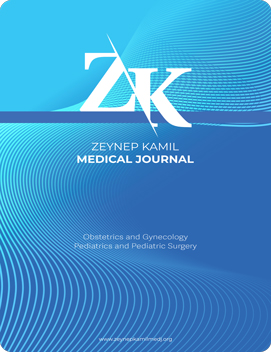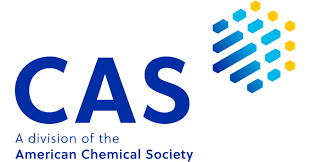Quick Search
Volume: 55 Issue: 4 - 2024
| FRONTMATTERS | |
| 1. | Cover Pages I - II |
| 2. | Editorial Board Pages III - XI |
| ORIGINAL RESEARCH | |
| 3. | An analysis of factors affecting fetal fraction in cell-free fetal DNA test for aneuploidy screening Işıl Ayhan, Salih Yılmaz doi: 10.14744/zkmj.2024.57441 Pages 175 - 178 INTRODUCTION: To analyze factors affecting fetal fraction in cell-free DNA (cfDNA) test for aneuploidy screening. METHODS: This is a retrospective cohort study conducted between 2018 and 2023. All pregnant women who had a cfDNA test for aneuploidy screening were included in the study. Maternal data, gestational age (GA) at the time of blood draw for the test, methodology of the chosen test, and results of cfDNA test (fetal fraction and risk status) were collected. Pregnancy outcome, GA at the time of delivery, pres-ence of hypertensive disorders of pregnancy (HDP), and neonatal outcomes were obtained and analyzed. RESULTS: Data from a total of 447 women were analyzed. The median GA at the time of the cfDNA test was 12 (1113) weeks. The median fetal fraction among women who have a healthy weight, who are overweight, and who are obese was 10.4% (7.713.1), 9% (7.112), and 7% (3.47.9), respectively (p=0.002). There were 12 (2.7%) cfDNA test results with low fetal fraction. All low fetal fraction results belonged to women who were obese (p<0.001). For each one-unit increase in BMI, there was a 0.4% drop in fetal fraction (95% CI 0.270.53). The decrease in fetal fraction remained significant when adjusted for maternal age and GA (-0.41, 95% CI 0.280.55). Maternal age, GA at the time of the test, and heparin and aspirin use were not associated with fetal fraction. DISCUSSION AND CONCLUSION: Maternal BMI has a negative effect on fetal fraction in cfDNA testing. Pre-test counseling should include factors influencing the fetal fractionand therefore the accuracyof cfDNA testing. |
| 4. | The effect of participation in pregnancy school trainings on perinatal comfort level Asibe Özkan, Belgin Aygördü Hamitoğlu doi: 10.14744/zkmj.2024.77044 Pages 179 - 186 INTRODUCTION: This research aimed to investigate the impact of pregnancy school training on the perinatal comfort levels experienced by women. METHODS: The research employed a case-control, quasi-experimental, descriptive, analytical, and relationship-seeking design. Conducted between June and December 2022, the study involved 64 pregnant women randomly selected from those who attended the hospitals registered pregnancy school training for 16 uninterrupted hours. These participants, who voluntarily joined the study, comprised the case group, contributing to a total sample size of 128 pregnant women. Data collection utilized a personal information form, developed by the researchers through a comprehensive literature review, and the Prenatal Comfort Scale (PCS). Statistical analysis was carried out using the Statistical Package for Social Science (SPSS) 20.0 package program. RESULTS: The educational status of the pregnant women and their spouses in the study group was higher than that in the control group (χ2: 14.040, p=0.015, χ2: 11.701, p=0.013), and there was no statistically significant difference between the two groups in terms of other descriptive characteristics. The analysis of the data showed that the women who attended pregnancy school trainings exhibited statistically higher rates of opting for planned/wanted pregnancies and normal births compared to the control group (χ2: 10.847, p=0.001; χ2: 3 4.696, p=0.000). Furthermore, more than half of the attendees at the pregnancy school were primiparous, leading to a statistically significant difference between the two groups (χ2: 8.708, p=0.020). In terms of PCS scores, the case group scored an average of 68.82±8.13, while the control group scored 61.07±6.88, demonstrating a statistically significant difference (z=22.689, p=0.000). DISCUSSION AND CONCLUSION: Participation in pregnancy schools demonstrated a positive impact on the overall comfort levels of the women in their third trimester of pregnancy. |
| 5. | Evaluation of lower uterine segment thickness in pregnant women with previous cesarean section and pain at term Mustafa Göksu, Pınar Kadiroğulları, Kerem Doğa Seçkin, Büşra Şahin, Yusuf Başkıran doi: 10.14744/zkmj.2024.94940 Pages 187 - 191 INTRODUCTION: The aim of this study was to evaluate the thickness of the lower uterine segment (LUS) by ultrasonography in patients with and without pain who had a previous cesarean section and to determine a cut-off thickness value that can predict uterine rupture by comparing the values found. METHODS: A total of 100 pregnant women with previous cesarean section who presented to the emergency department with pain and 100 pregnant women without pain who were scheduled for elective cesarean section were evaluated. In both groups, endometrial wall thickness was measured by ultrasonography at presentation. Intraoperative findings were recorded according to the Qureshi scoring system. RESULTS: An LUS thickness of 1.75 mm was considered the critical cut-off value, obtained from the ROC curve with 90% sensitivity and 90% specificity using transabdominal ultrasonography. Linear regression model analysis revealed that a full LUS thickness <1.75 mm was the only factor associated with a translucent uterine segment (C3). DISCUSSION AND CONCLUSION: We found an increased risk of uterine rupture at an ultrasonographic thickness <1.75 mm in pregnant women with pain and previous cesarean section. Ultrasonographic niche measurement will enable appropriate obstetric care to prevent adverse maternal and fetal outcomes and will alert physicians for a planned cesarean section. |
| 6. | Laparoscopic tubal reanastomosis: 10-year pregnancy results of a single tertiary center Eralp Bulutlar, Gizem Berfin Uluutku Bulutlar, Resul Karakuş, Sultan Seren Karakuş, Gizem Boz İzceyhan doi: 10.14744/zkmj.2024.74317 Pages 192 - 195 INTRODUCTION: This study aims to investigate whether tubal reanastomosis can be considered a superior or alternative method to in vitro fertilization (IVF) for women who have previously undergone tubal ligation but wish to conceive again. The focus is on assessing tubal reanastomosis as an option for patients seeking natural conception after changing their minds for various personal reasons. The study specifically evaluates this method in relation to IVF, particularly in cases where factors such as age, ovarian reserve, and partner spermiogram values are considered. METHODS: This clinical trial and case series study screened women who had previously undergone tubal ligation and later applied to the Gynecology and Obstetrics Service at Zeynep Kamil Hospital between 2012 and 2022. From this group, 86 women were deemed suitable for surgery and underwent tubal reanastomosis. Postoperative pregnancy rates and outcomes, including abortion, ectopic pregnancy, and term delivery rates, were analyzed to assess the effectiveness of tubal reanastomosis. RESULTS: The pregnancy rate following tubal reanastomosis was 33% within the studied group. Among these pregnancies, 8% ended in abortion, 3% resulted in ectopic pregnancies, and 89% reached full term. Tubal reanastomosis was shown to be a cost-effective method compared to IVF, avoiding complications associated with IVF, such as multiple pregnancies and ovarian hyperstimulation syndrome (OHSS). The method also demonstrated high patient compliance and success rates. Additionally, it allowed for simultaneous surgical intervention for co-existing conditions, such as endometrial polyps, ovarian cysts, fibroids, and adhesions. DISCUSSION AND CONCLUSION: Tubal reanastomosis presents as an effective alternative treatment op-tion to IVF for select patient groups, with favorable pregnancy rates and fewer associated complications. It is particularly suited for patients who are younger, have adequate tube length after ligation, a favorable hormone profile, and a supportive partner spermiogram. This method is less costly, has fewer risks, and offers a viable path to conception for those seeking natural pregnancy after tubal ligation. |
| 7. | Comparison of hemogram parameters in pregnant women with gestational diabetes mellitus and healthy pregnant women Mehmet Kağıtçı, Nalan Kuruca, Deniz Dereci Delibaş, Şenol Şentürk doi: 10.14744/zkmj.2024.90775 Pages 196 - 200 INTRODUCTION: Gestational diabetes mellitus (GDM) is the most common endocrinopathy in pregnant women. The aim of this study is to investigate the relationship between changes in complete blood count parameters, a common and inexpensive test, and GDM. METHODS: In this retrospective study, changes in the complete blood count parameters of pregnant women who underwent a 75-gram oral glucose tolerance test at 2428 weeks of gestation between October 2021 and October 2022 were compared with healthy pregnant women. RESULTS: A total of 424 pregnant women were included in the study. Of these, 107 (25.2%) were in the GDM group, and 317 (74.8%) were in the control group. The levels of white blood cell, neutrophil, red blood cell, hemoglobin, and hematocrit were higher in the GDM group (p=0.015, 0.02, 0.025, 0.01, 0.000). Basophil and mean corpuscular hemoglobin concentration (MCHC) levels were found to be lower in GDM patients (p=0.029, 0.009). Logistic regression analyses showed relationships between age, basophil, MCHC, and hematocrit levels. ROC analyses of the relevant blood parameters showed low sensitivity or specificity. DISCUSSION AND CONCLUSION: Complete blood count parameters are affected in GDM patients, but clinical use seems challenging. Advanced age is also associated with an increased GDM risk. |
| 8. | Preoperative MgSO4 treatments effect on depth of anesthesia during general anesthesia for cesarean section evaluated by bispectral index monitoring Evrim Bozay Öz doi: 10.14744/zkmj.2024.56563 Pages 201 - 206 INTRODUCTION: The depth of anesthesia is adjusted by the dosage of anesthetic agents used. During cesarean section, parenteral opioid analgesics can cause side effects for both the pregnant individual and the fetus. Because of these risks, using lower doses of medication is preferred; however, this comes with a significant challenge, such as keeping the patient awake. Adjuvant substances that reduce the required dosage and increase the effectiveness of anesthetic agents are therefore needed. Magnesium sulfate (MgSO4) is one of the most commonly used minerals as an adjuvant in anesthesia. The efficiency of perioperative MgSO4 use on the depth of anesthesia and hemodynamic changes in patients undergoing general anesthesia during cesarean surgeries was investigated using Bispectral Index Monitoring. METHODS: Thirty-six patients who received MgSO4 intravenous treat-ment before the cesarean section (Group 1) and 36 patients who did not receive MgSO4 treatment as controls (Group 2) were evaluated. For both groups, blood pressure, heart rate, and oxygen saturation parameters (SBP, DBP, MBP, HR, SpO2) were collected for hemodynamic comparison, and BIS values were collected for the evaluation of anesthesia depth. BIS measurements were grouped into two categories for statistical analysis regarding anesthesia depth levels: values of 060 were accepted as hypnosis, and 6080 were accepted as sedation. RESULTS: There was no statistically significant difference between Group 1 and Group 2 in terms of demographic data, ASA, SBP, DBP, MBP, HR, and SpO2 values. However, there were statistically significant differences between the BIS and anesthesia depth levels of Group 1 and Group 2 at the 5th, 10th, 14th, 18th, 22nd, 26th, and 30th minutes of the operation. For intragroup time interval comparisons, the changes in SBP and HR values at the 26th and 30th minutes were found to be significantly lower than the baseline values in Group 1. DISCUSSION AND CONCLUSION: This study showed that the administration of MgSO4 in the preoperative period of cesarean sections could provide a stable and deep level of anesthesia using the same doses of anesthetic substances in pregnant individuals. |
| 9. | Evaluation of the relationship between polycystic ovary syndrome and intestinal inflammation as measured by fecal calprotectin levels Bihter Senem Feyzioğlu, Zerrin Avul doi: 10.14744/zkmj.2024.90692 Pages 207 - 212 INTRODUCTION: Factors such as chronic inflammation and oxidative stress are pivotal in the pathogenesis of polycystic ovary syndrome (PCOS). We aimed to evaluate the relationship between PCOS and fecal calprotectin levelsa proxy for intestinal inflammation. METHODS: This research was carried out by including 54 women who applied to the obstetrics and gynecology clinic of our hospital. Twenty-seven of these women were diagnosed with PCOS, while 27 were healthy. RESULTS: Median fecal calprotectin in women with PCOS was significantly higher than in controls (p=0.040). Calprotectin had 37.0% sensitivity, 96.3% specificity, and 66.7% accuracy in predicting PCOS patients with a cut-off value of ≥60 (area under ROC curve: 0.667 (95% CI: 0.5200.813), p=0.036). Multiple logistic regression showed that free androgen index was the only parameter independently associated with PCOS presence. DISCUSSION AND CONCLUSION: Fecal calprotectin level is increased in PCOS, and therefore, it appears that intestinal inflammation is increased in our PCOS groupdespite similar levels of systemic inflammation. Fecal calprotectin may be valuable in the differential diagnosis of PCOS, and therapies targeting intestinal inflammation warrant research for their possible benefits in women with PCOS. |
| 10. | Does Vasoactive Inotrope score predict morbidity and mortality in premature babies weighing less than 1000 grams? Elif Özalkaya, Emre Yarış, Güner Karatekin doi: 10.14744/zkmj.2024.46762 Pages 213 - 222 INTRODUCTION: The vasoactive inotropic score (VIS) was first used to assess inotropic exposure in neonates with congenital heart disease and was subsequently shown to predict postoperative mortality. The aim of this study is to evaluate the relationship between VIS and morbidity and mortality in preterm infants. METHODS: This is a retrospective and cross-sectional study. The files of 77 premature babies weighing less than 1000 grams, who were hospitalized in the Neonatal Intensive Care Unit at the University of Health Sciences Zeynep Kamil Maternity and Childrens Training and Research Hospital between January 2019 and January 2020, were evaluated retrospectively. Demographic data, antenatal and perinatal findings, postnatal clinical findings, postnatal 1st and 48th hour systolic, diastolic, and mean blood pressures, pH, base deficit, and lactate values were recorded. The maximum VIS (VISmax) at the postnatal 48th hour was calculated. RESULTS: In the preterm infants, a VISmax value of 80 (85% sensitivity, 47% specificity) and a VISmax value of 7.5 (97% sensitivity, 57% specificity) were found to be predictive for pulmonary hypertension and mortality, respectively. DISCUSSION AND CONCLUSION: A VISmax value of 7.5 and a VISmax value of 80 predict mortality and pulmonary hypertension in preterm infants with extremely low birth weight. Further studies are needed. |
| 11. | Retrospective evaluation of children referred to the pediatric neurology department with complaints of vertigo/dizziness Emek Uyur, Merve Özen, Nilüfer Eldeş Hacıfazlıoğlu, Özlem Erdede doi: 10.14744/zkmj.2024.72602 Pages 223 - 228 INTRODUCTION: Vertigo/dizziness is a common symptom in childhood and adolescence. Although it is often not associated with an important underlying disease, sometimes it can indicate a serious illness. This study aimed to evaluate the demographic characteristics, etiology, and clinical and laboratory findings of patients referred to the pediatric neurology outpatient clinic with complaints of vertigo/dizziness. METHODS: The data of 109 patients who were referred to the Pediatric Neurology outpatient clinic between January 2019 and April 2021 with complaints of vertigo/dizziness were evaluated retrospectively. RESULTS: Of the patients, 60 (55%) were female and 49 (45%) were male. The mean age was 12.5. Seven of the patients (6.4%) were between the ages of 25, 13 (11.9%) were between the ages of 510, and 89 (81.7%) were between the ages of 1018. Etiological groups included orthostatic hypotension (23.9%), somatoform causes (15.6%), peripheral vertigo (vestibular neuritis) (11%), vitamin B12 deficiency (10.1%), migraine (8.3%), cardiac causes (4.6%), mastoiditis/sinusitis (4.6%), epileptic vertigo (2.8%), trauma (1.8%), demyelinating lesions (1.8%), benign paroxysmal vertigo (1.8%), hypoglycemia (0.9%), drug side effects (0.9%), visual problems (0.9%), and intracranial mass (0.9%). The most common complaints accompanying dizziness were headache (41.2%), blackout (36.7%), and nausea-vomiting (20.2%). A statistically significant difference was found between age groups in etiology (p<0.05). Benign paroxysmal vertigo and life-threatening causes (intracranial mass, demyelinating disease) were prominent in the age group of 25 years; migraine and sinusitis between the ages of 510 years; and orthostatic hypotension, somatoform problems, and peripheral vertigo between the ages of 1018 years. DISCUSSION AND CONCLUSION: Although the etiological spectrum of vertigo is quite broad, benign causes are more common. Causes prominent in the etiology differ according to the age range. In the presence of accompanying signs and symptoms, differential diagnosis should be made systematically for life-threatening conditions. |
| CASE REPORT | |
| 12. | Secondary postpartum hemorrhage of an adenomyotic patient after a history of atony managed with B-Lynch sutures: A case report Ecem Yağmur Demir Seymenoğlu, Müşerref Banu Yılmaz doi: 10.14744/zkmj.2024.04207 Pages 229 - 231 Secondary postpartum bleeding is defined as abnormal uterine bleeding occurring between the 24th hour and the 12th week postpartum, affecting approximately 12% of postpartum women. In the c-section of a 19-year-old pregnant woman (gravida 2, para 1, c-section 1) at term with polyhydramnios, uterine atony was managed with medical treatment and hemostatic B-Lynch sutures. After being discharged on the third day with no abnormal findings, she presented with acute, abundant vaginal bleeding on postpartum day 15. The uterus was semi-contracted, with subinvolution. Ultrasound revealed a 21 mm heterogeneous area in the endometrium and adenomyosis. The bleeding was managed with uterotonics and intrauterine balloon tamponade following revision curettage, and was attributed to late atony. Due to the timing of secondary postpartum hemorrhage and its rarity, there is a high probability of misdiagnosis. To prevent serious morbidity and mortality, the etiology should be evaluated promptly, and appropriate intervention should be undertaken. |
| OTHER | |
| 13. | Reviewer List Page 232 Abstract | |
















